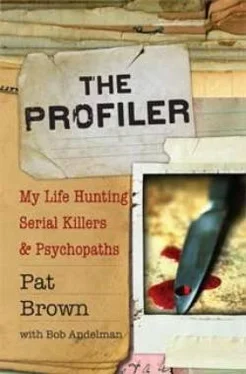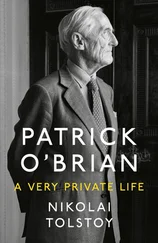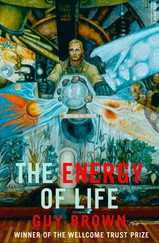Everyone I asked for an interview agreed. The family did not seem shocked or shaken that I was investigating him in connection with a sexual homicide. How many families would not object to a stranger sitting in their living room and questioning them as to whether their son, brother, brother-in-law, or uncle might be a murderer? Walt’s family members weren’t upset at all. Not one of them.
* * * *
I TOOK THE information gained from my interviews and turned it over to the police department that had jurisdiction over the crime. In the beginning there had been a dispute over who should work the case; the park police, because Anne Kelley was murdered in the park, or the county police, because the park was within county jurisdiction. It would have been better for the county police to handle the case, because they had a lot of experience with murder investigations and the park police had very little. I never knew why the park police won out, but it was clearly their case. I had to go back to them with my new information and I got another tepid response, but I handed over the information anyway and went away again. I had compiled a substantial history on Walt, including all the places I knew he had worked, and a list of his old girlfriends. Whether he murdered Anne Kelley or not, I did not know, because that must be proved with evidence, but based on my investigation, there was no doubt in my mind that he should be a suspect or at least a person of interest. Information about him now came not just from one “bored housewife” but also from employers, family, and friends. Now there were even more reasons for the police to take a look at Walt Williams. I could only hope they would.
IN THE SPRING of 1996 I got the phone call that I had been waiting for for the last six years. Walt Williams finally became the number one suspect in the murder of Anne Kelley.
A new investigator had taken over the case, and he said, “Can you come in? I want to interview you about Walt Williams.”
I said, “Thank God.”
We talked the next day at police headquarters. I was back in the same building I had first walked into carrying my cardboard box of evidence all those years before. The investigator looked at me, motioned toward the evidence-my evidence-sitting on the table in between us, and shook his head. “I don’t know why they missed this the first time around. This is crazy. This is crazy.”
The police picked Walt up, brought him in for an interview, and polygraphed him. The police told me afterward that they laughed about his interview because it was full of bogus information. They were most amused that he had been given the “option” to leave the air force as part of a “Manpower Reduction Program.” They said that he now had an alibi for the night that Anne Kelley was murdered, that he had been playing softball at the time. That was an alibi we could strike down, because he told me that he left Kim’s and came back to the house. He never mentioned a softball game to me.
The polygraph showed that he was being deceptive. “He’s our guy. We know it’s him. We got his DNA and we’re waiting on the test to come back.” I don’t know if Williams gave consent for the tests willingly or if he was pressured into it or if there was a court order, but I was happy to hear that they were going after physical evidence.
Then the investigator looked at me and said, “You should watch your back. Walt’s really angry now.”
I said, “Can I get a Maryland gun permit? A carry permit?”
The police said no. In Maryland, you can get a carry permit only if your life is being threatened, and since Walt hadn’t threatened me, I couldn’t get one.
So that was that. I went home, relieved it was almost over, exhilarated that all my hard work had paid off, and thankful my analysis of Walt Williams hadn’t been so wrong after all. Then I waited, and I waited, and I waited.
People think DNA tests come back quickly, but this one took five months. While intellectually I never thought he’d come after me, and he didn’t, emotionally it was unnerving to know that he was out there and angry. He knew who turned him in and he heard that I had visited his relatives asking questions, so there was no doubt in his mind that he ended up being interviewed by the police six years after the murder because of me.
I kept calling and calling the police station. “What’s going on, what’s going on?” Finally the investigators received the test results.
“Walt has been excluded by the DNA,” the detective told me.
“WHAT?” I shrieked.
He said, “Yeah, the DNA excluded him. He’s no longer a suspect.”
I went berserk. I was just blown away. I could not understand it. “What are you talking about?”
“He’s been excluded.”
“I don’t believe this,” I said. “I can believe that it’s inconclusive-that I can buy. ‘It’s inconclusive’-we don’t have enough DNA to prove he did or didn’t do it. I can accept that and it’s okay with me if you can’t take it to court. You can tell me that and I’m not going to hound you over it. But please don’t lie to me.”
“Mrs. Brown,” he said, “you need to get a life.”
I DID GET a life, and I decided something needed to be done about the police investigative system, because I no longer believed that catching killers was being handled properly. The system was failing and innocent people, mostly women, were going to be killed because of it.
Some people said, “You just can’t accept defeat. You totally believe this guy killed this girl, and that’s all there is to it. No matter what evidence there is, you’re going to believe he did it, and you won’t admit you were wrong. You’ve got some kind of issue that you’ve just got to prove yourself. You’re just obsessed.”
But my problem wasn’t that. The investigator’s justification didn’t make sense to me. I’d grown distrustful of how the system worked, and I wanted proof. Six years ago I was told Michael Potter killed Anne Kelley, but that was never proven. Now I was being told Walt didn’t do it and they were looking for someone else. If Walt’s DNA didn’t match the DNA at the crime, then he was innocent. But I wanted proof. Prove to me he didn’t commit the crime.
For a year, I called and called, pushing for the right to see the DNA report. I was always refused. One day, for some reason, I got hold of another investigator and he read the DNA report to me! Go figure. But what a bonanza, because that officer said, “There were no PCR products obtainable from the sperm factions.” In other words, There was no DNA. A later statement by the Maryland State ’s Attorney’s Office confirmed what the detective had told me: “There is no DNA evidence to take anyone to trial.”
One of the reasons they could not confirm that Anne’s killer was Walt was that there simply wasn’t any DNA found in or on Anne Kelley that could link him to the murder. The results were inconclusive. He had not been excluded.
I was furious, because the investigator did lie to me.
Now I knew that the DNA was inconclusive and that Walt should still be a suspect. And I wondered whether they ever tested the condom I found in his trash. It didn’t seem that they had, but if he were the killer, the victim’s DNA might have been found on that. I guess they didn’t think killers ever used them.
SOMETIMES I LOOK back at the Anne Kelley case and I realize the first investigator wasn’t especially skilled at solving cases. The park police had never had a murder in their jurisdiction before, so this guy probably had little or no experience in homicide or criminal profiling or psychopathology. And in comes a housewife with a box, she tells him a great story, and he shrugs it off.
And then there were the politics involved in the particular case, which no one could have predicted and I didn’t learn about until almost a decade after the crime.
Читать дальше












